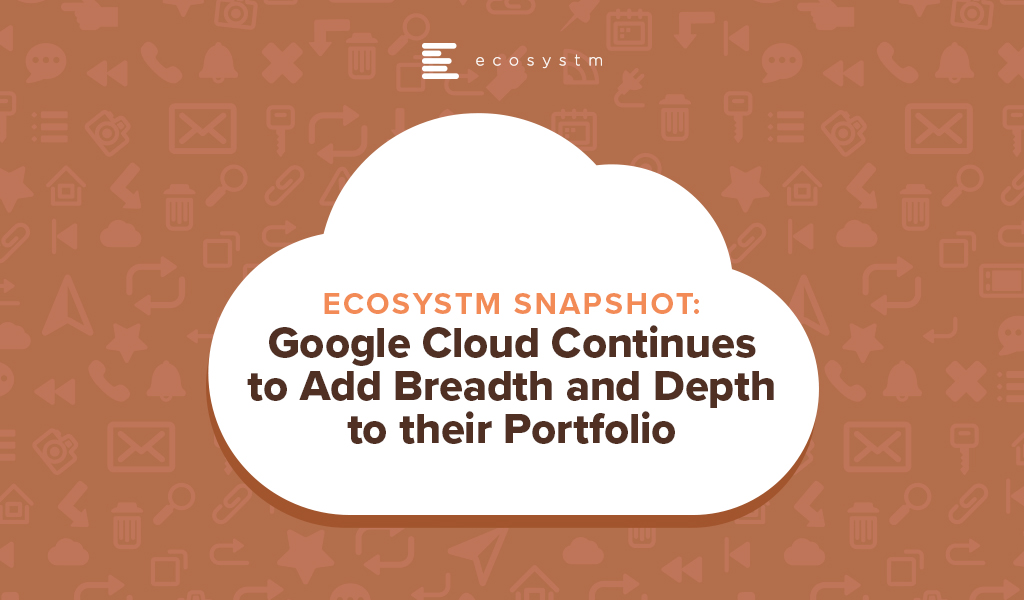Talking about the top 5 global cloud players – Microsoft, AWS, Google, Alibaba and IBM – in the Ecosystm Predicts: The Top 5 Cloud Trends for 2020, Ecosystm Principal Analyst, Claus Mortensen had said, “their ability to compete will increasingly come down to expansion of their service capabilities beyond their current offerings. Ecosystm expects these players to further enhance their focus on expanding their services, management and integration capabilities through global and in-country partnerships.” Google Cloud is doing just that. The last week has been busy for Google Cloud with a few announcements that show that it is ramping up – adding both depth and breadth to their portfolio.
Expanding Data Centre Footprint
This year Google Cloud is set to expand the number of locations to 26 countries. Earlier in the year, Google CEO Sundar Pichai had promised to invest more than US$ 10 billion in expanding their data centre footprints in the USA and they have recently opened their Salt Lake City data centre. Last week Google announced four new data centre locations in Doha (Qatar), Toronto (Canada), Melbourne (Australia), and Delhi (India). With Australia, Canada and India, Google appears to be following the same policy they followed in Japan – where locations in Osaka and Tokyo give customers the option to have an in-country disaster recovery solution. Doha marks Google Cloud’s first foray into the Middle East. While the data centre will primarily cater to global clients, Google has noted a substantial interest from customers in the Middle East and Africa.
Mortensen says, “Google’s new data centres can be seen as an organic geographical expansion of their cloud services but there are a few more factors at play. With data privacy laws getting stricter across the globe, the ability to offer localised data storage is becoming more important – and India is a very good example of a market where keeping data within the geographical borders will become a must.”
“The expansion will also help the development of Google’s own edge computing services going forward. As we noted in our Ecosystm Predicts document, we believe that Cloud and IoT will drive edge computing (which is tightly tied to 5G). Edge computing will function in a symbiotic relationship with centralised data centres where low latency is important. The geographical expansion of Google’s data centre presence will thus also help their push towards edge computing services.”
Google offers their cloud infrastructure and digital transformation (DX) solutions to customers in 150 countries. Not only are they expanding their data centre footprint, but they are also creating industry differentiation. They have targeted industry-specific solutions that deliver new digital capabilities in 6 key verticals – financial services; telecommunications media and entertainment; retail; healthcare and life sciences; manufacturing and industrial; and public sector.
Partnering with Telecom Providers
Last week also saw the unveiling of the Global Mobile Edge Cloud (GMEC) aimed at the telecom industry’s need to transform and the challenges it faces. The telecom industry – long considered an enabler of DX in other industries – stands at a crossroads now. It is time for the industry to transform in order to succeed in a challenging market, newer devices and networking capabilities, and evolving customer requirements – both consumer and enterprise. Talking about the impact of 5G on telecom providers, Ecosystm Principal Advisor, Shamir Amanullah says, “5G is an enterprise play and leading tech giants, carriers and the companies in the ecosystem are collaborating and inking partnerships in order to create solutions and monetise 5G opportunities across industries.”
Google Cloud announced a partnership with AT&T, which is meant to leverage AT&T’s 5G network and Google Cloud’s edge compute technologies (AI and machine learning, analytics, Kubernetes and networking) to develop a joint portfolio of 5G edge computing solutions. This is part of Google’s larger strategy of supporting telecom providers in their efforts to monetise 5G as a business services platform. Through the GMEC, Google Cloud will partner with carriers to offer a suite of applications and services at the edge via 5G networks.
The telecom industry is a key focus as Google aims to help operators take 5G to market, by creating solutions and services that can be offered to enterprises. This includes better customer engagement through data-driven experiences, and improvement of operational efficiencies across core telecom systems. Telecom providers such as Vodafone and Wind Tre are leveraging Google to improve customer experience through data-driven insights.
Amanullah says, “Google Cloud already has thousands of edge nodes inside the carrier networks which will be enabled for use by enterprises, providing access to data analytics, AI and machine learning capabilities. Carriers can offer enterprises these data-driven solutions, to transform the customer experience they offer. Google will also create solutions which will enable carriers and enterprises to improve infrastructure and operational efficiencies through modern cloud-based Operations Support Systems (OSS) and Business Support Systems (BSS).”
Mortensen also thinks that the data centre expansion should be seen in the light of Google’s GMEC push. “Both India and the Middle East are big potential markets via the local telecom providers.”
In the Top 5 Cloud Trends for 2020, Principal Analyst Claus Mortensen observed that 2020 is a do-or-die year for Oracle if they wanted to remain as a key contender in the Cloud market. Mortensen said, “Oracle has not been able to break into Cloud in the same way as their competitors and has so far not made the same “leap of faith” into this area as similar companies have. Unless the company makes a clear decision about their Cloud strategy and succeeds in communicating it to the market in 2020, Oracle may quickly find itself more of a niche Cloud player going forward.”
Oracle’s intentions to remain one of the leading global Cloud providers becomes clear as they actively expand their global coverage. Last week Oracle announced that, as part of their ongoing regional expansion plan, they have added local regions in Jeddah (Saudi Arabia), Melbourne (Australia), Osaka (Japan), Montreal (Canada) and Amsterdam (The Netherlands). This expands the reach of Oracle’s Generation 2 Cloud to 21 independent locations, and Oracle intends to further add 15 locations by the end of 2020. At OpenWorld last year, Oracle had announced their plans to have Cloud sites dedicated to the enterprise market as well as government customers.
Dr Alea Fairchild, Principal Advisor Ecosystm, thinks that Oracle appreciates the needs of their enterprise customers. “Oracle understands the sensitivity of the enterprise to the location and availability of their data, which remains an issue with Cloud implementations involving large data sets. They have broken some ground as the first public Cloud vendor with data centres in Saudi Arabia, and are putting efforts in to offer a minimum of two regions in almost every country in which they operate,” says Dr Fairchild. “From a corporate user’s perspective, regional data management and appropriate licensing models are still sensitive spots when it comes to database management.”
Getting Ready for the Hybrid Cloud Market
Oracle also appears to be ramping up for the growing hybrid Cloud market. Ecosystm research shows that more than a third of global organisations have adopted the hybrid Cloud and this will only increase. Given the increased uptake of hybrid and multi-cloud environments, Oracle offers preconfigured links between Oracle and Microsoft Azure cloud regions in the eastern states of the US, London, and Toronto, as part of the Cloud interoperability partnership announced in June 2019. Last year, saw another mutually beneficial partnership between VMWare and Oracle, that supports their customers’ hybrid cloud strategies, allowing the VMware Cloud Foundation to run on Oracle Cloud Infrastructure. Organisations can also avail technical support for Oracle software running in VMware environments both in on-premise data centres and Oracle-certified cloud environments.
“Oracle’s Generation 2 Cloud is now available in 21 locations and is on track to have a total of 36 Cloud regions up and running by the end of the year,” adds Dr Fairchild. “But when compared to AWS, Microsoft and IBM, Oracle still holds a fraction of the market share. They can be seen as a niche infrastructure provider, but indeed the partnerships with Microsoft and VMware are set to help Oracle’s Cloud business make traction with companies that are adopting multi-cloud strategies.”



